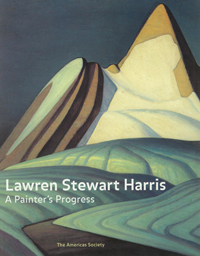Lawren Stewart Harris: a Painter’s Progress
On view:
through
Lawren Stewart Harris: a Painter’s Progress
 Lawren Stewart Harris: a Painter’s Progress constituted the first full-scale retrospective of Harris’s oeuvre anywhere since 1963. Forty-six paintings traced a career that spanned six decades and was defined by a truly modernist commitment to experimentation and the idea of art as a constant progression. Gritty yet atmospheric scenes of urban life in Toronto and vividly colored Post-Impressionist streetscapes comprised the first section. This section culminated in Harris’s magisterial Group of Seven landscapes, which became progressively more abstract while reflecting a profound and sustained meditation on the natural world of Canada (i.e. the woods of northern Ontario, the grandeur of the Canadian Rockies, and the stark emptiness of the Arctic).
Lawren Stewart Harris: a Painter’s Progress constituted the first full-scale retrospective of Harris’s oeuvre anywhere since 1963. Forty-six paintings traced a career that spanned six decades and was defined by a truly modernist commitment to experimentation and the idea of art as a constant progression. Gritty yet atmospheric scenes of urban life in Toronto and vividly colored Post-Impressionist streetscapes comprised the first section. This section culminated in Harris’s magisterial Group of Seven landscapes, which became progressively more abstract while reflecting a profound and sustained meditation on the natural world of Canada (i.e. the woods of northern Ontario, the grandeur of the Canadian Rockies, and the stark emptiness of the Arctic).
The central section featured works from the 1930s and ’40s, the time when Harris made the momentous shift from idealized views of nature to non-objective compositions that expressed the nature of the ideal. In 1934, at a personal and professional turning point, Harris moved to the United States, settling first in Hanover, New Hampshire, where he was an artist-in-residence at Dartmouth College. By the time he moved to Taos, New Mexico, in 1938, he was already creating entirely abstract compositions. This pivotal section used the 1939 New York World’s Fair as a reference point, grounding Harris’s abstraction and spiritual ideas within the new utopian religion of science and technology promoted by the fair, where Harris and other Transcendentalists exhibited. Harris became the president of the TPG and continued to create abstract, geometric paintings that were influenced by spiritual, as well as formal, concerns. Harris and the other members of the TPG embarked upon a project to create an art inspired by nature, but bound by what they saw as the immutable laws of a divine, unseen realm.
Late abstractions from the 1950s and ’60s composed the third section of the exhibition. Executed exclusively in Vancouver, they displayed a loosening-up of his approach, but they also represented an artist who had become isolated in his work, out-of-sync with the prevailing trends in his community, yet strongly committed to his own personal vision.
The exhibition Lawren Stewart Harris: a Painter’s Progress and its programs received generous assistance from the Canadian Consulate General, New York and the Québec Government House, New York.







